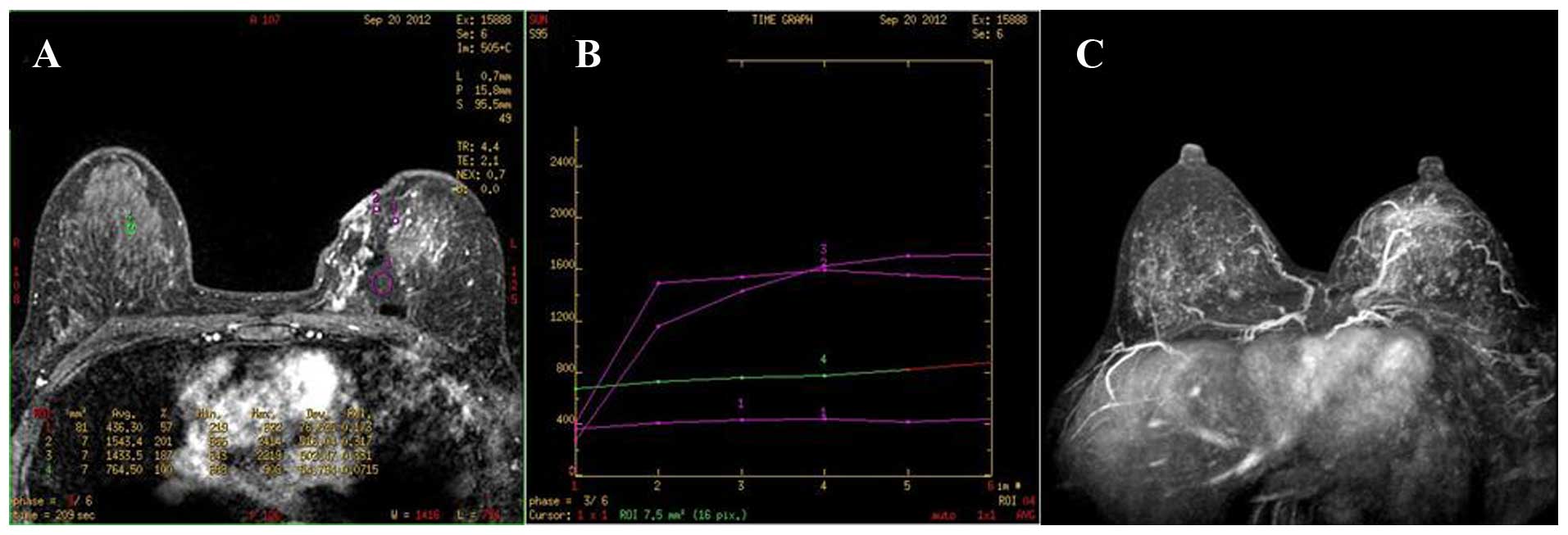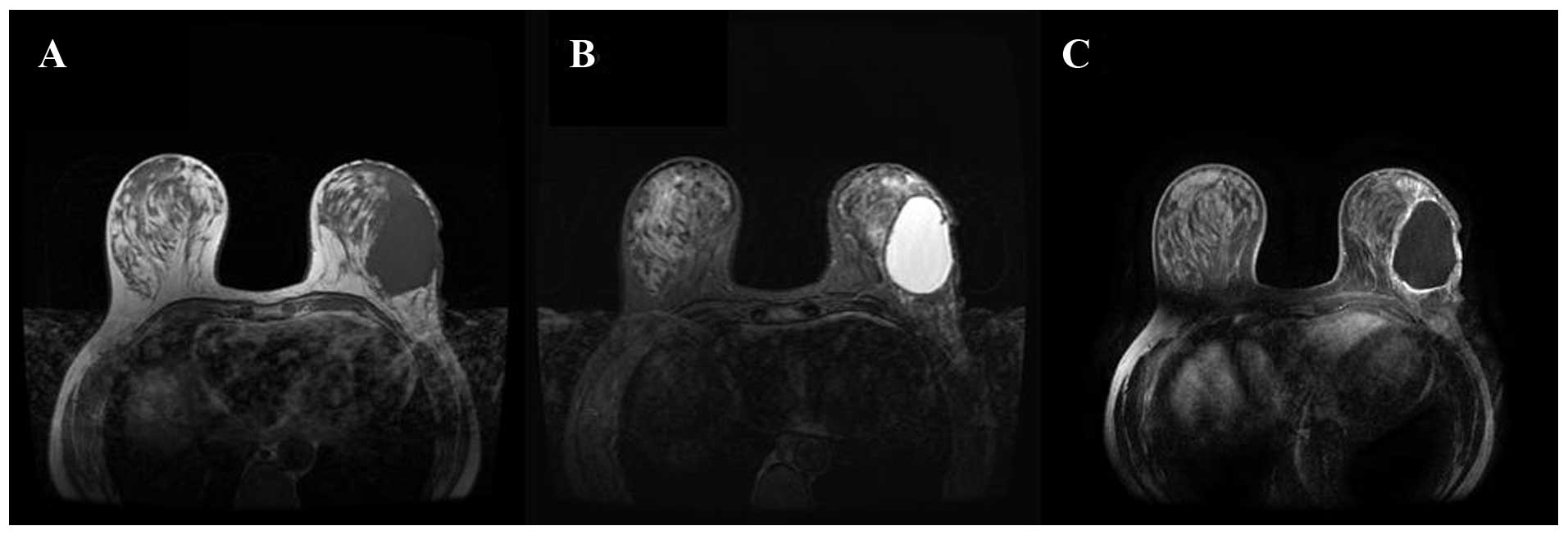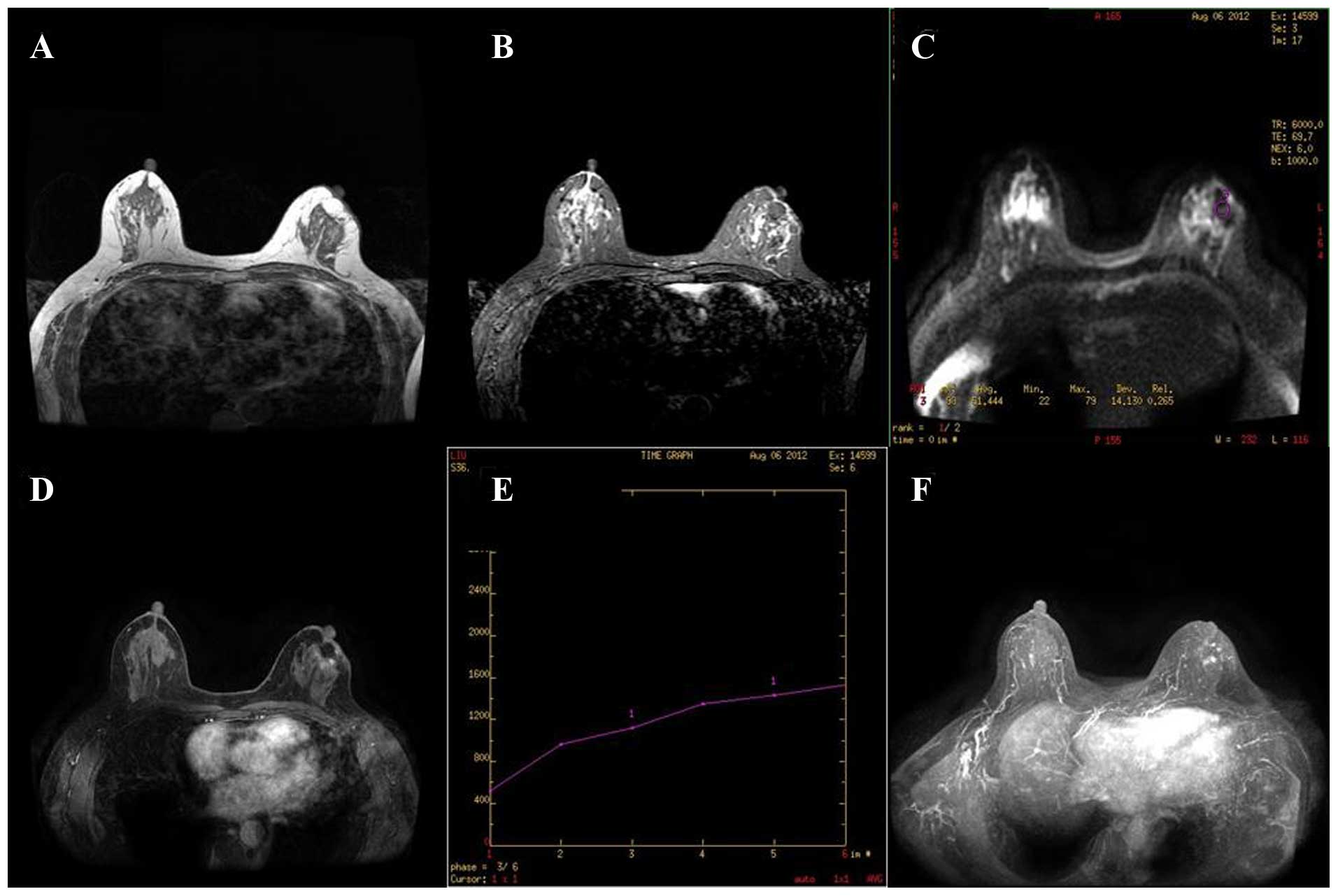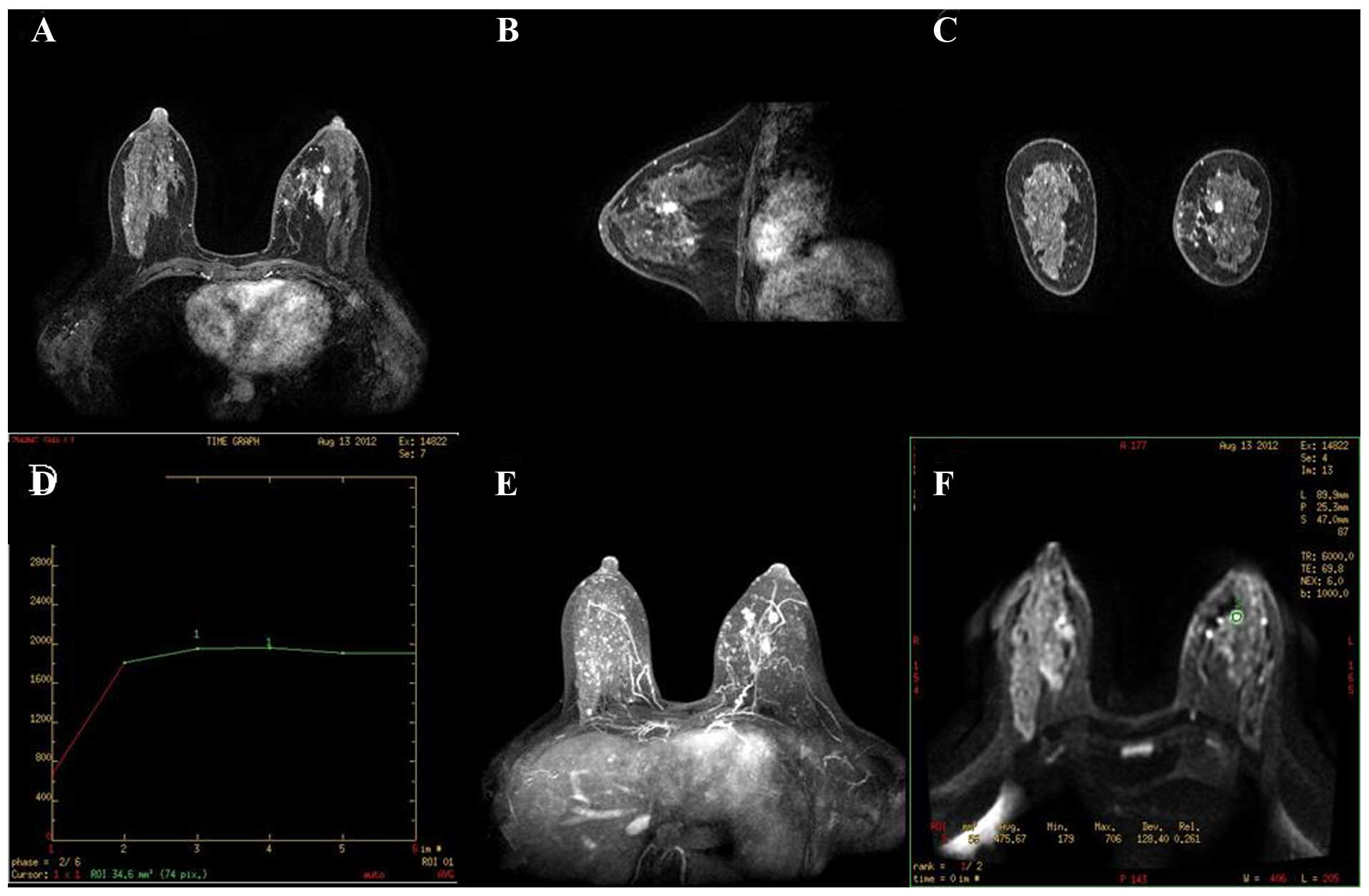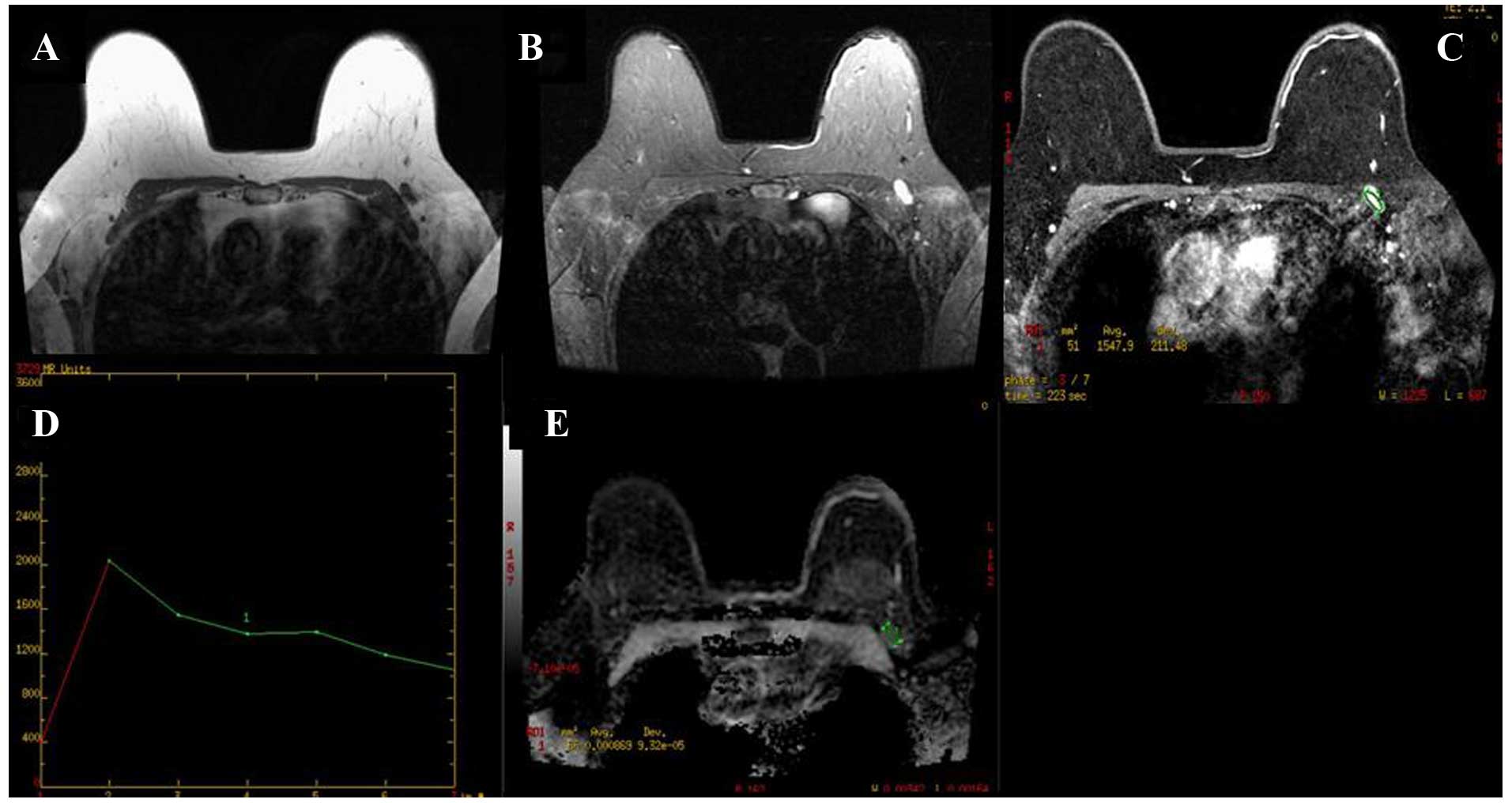Role of short-term follow-up magnetic resonance imaging in the detection of post-operative residual breast cancer
- Authors:
- Published online on: June 9, 2016 https://doi.org/10.3892/mco.2016.923
- Pages: 388-394
Abstract
Introduction
Technological improvements in the field of medical imaging, including mammography, ultrasonography and magnetic resonance imaging (MRI), have markedly enhanced the accuracy for breast cancer diagnosis in the early stage (1–3). However, false-positive and false-negative diagnosis of breast cancer based on imaging remains (4,5). Therefore, intraoperative frozen section diagnosis has a vital role in guiding appropriate therapeutic decision making for breast carcinoma patients and is widely used in the clinic (6,7). However, due to reasons such as poor quality of frozen sections, incorrect sampling procedures and limited experience of pathologists, the average accuracy of diagnoses based on intraoperative frozen pathology was 92.6–98.0% (8). Misdiagnosis based on intraoperative frozen pathology may lead to the selection of an inappropriate breast surgical procedure, resulting in incomplete tumor resection or unnecessary removal of the whole breast.
False-negative cases require a second surgery as soon as possible in order to remove the residual tumor and ensure tumor-free surgical margins. Prior to the second surgery, the detailed condition of the postoperative breast must be known in order to develop an appropriate surgical plan. For this, a precise breast imaging reexamination is important. Mammography is not suitable for immediate postoperative imaging as compression of the breast may lead to wound dehiscence. Ultrasound examination is also not suitable for postoperative imaging, as the image quality is usually largely affected by local structural disorders and edema in the surgical area. MRI is now widely accepted as the most accurate imaging modality for assessment of breast tumors, as it is capable of detecting unsuspected multifocal/multicentric or contralateral breast cancers and is suitable for guiding therapeutic decisions (9–11). Therefore, MRI was used as the imaging reexamination method in the present study.
Materials and methods
Patients
Between January 2011 and December 2013, 10 breast cancer patients diagnosed with non-malignant breast lesions by preoperative clinical and imaging examinations, as well as by intraoperative frozen section pathology, but who were finally confirmed as having malignant breast lesions by paraffin-embedded tissue histology, were included in the present study. All the patients were females with an average age of 37.8±12.9 years (range, 19–57 years). Six of the cases had non-specific invasive ductal carcinoma, 3 had intraductal carcinoma and 1 had endocrine carcinoma. Clinical data of the patients are listed in Table I. The present study was approved by the Ethics Committee of Xi'an Jiaotong University (Xi'an, China) and all patients gave written informed consent prior to enrolment in the study.
MRI acquisition and analysis
All patients were subjected to MRI examination between days 2 and 28 after the first surgery with an average time interval of 15 days.
MRI was performed using a 3.0-T system (GE Signa HDxt; GE Healthcare, Milwaukee, WI, USA). All patients were examined in a prone position using a double breast coil. An axial fat-suppressed T2-weighted short-TI inversion recovery sequence was performed with the following parameters: Repetition time (TR)/echo time (TE), 8,800.00 msec/33.88 msec; field of view, 320.00 mm; matrix size, 512×512; and slice thickness, 4 mm with a 1-mm gap. An axial T1 sequence was performed with the following parameters: TR/TE, 580 msec/7.20 msec; field of view, 320.00 mm; matrix size, 512×512; and slice thickness, 4 mm with a 1-mm gap. An axial echo-planar imaging (EPI)-diffusion-weighted imaging (DWI) sequence (b=1,000) was performed with the following parameters: TR/TE, 6,000 msec/69.60 msec; field of view, 320.00 mm; matrix size, 256×256; and slice thickness, 4 mm with a 1-mm gap. An axial Vibrant+C sequence was performed with the following parameters: TR/TE, 4.29 msec/2.10 msec; field of view, 320.00 mm; matrix size, 512×512; and slice thickness, 1.4 mm with a 0.7-mm gap. The contrast agent (Omniscan®; GE Healthcare, Cork, Ireland; 0.1 mmol/kg body weight) was manually injected at the beginning of the 5th acquisition, followed by 10 cc saline to flush in all contrast medium. Two experienced radiologists independently reviewed the images using ImageJ 1.44p software (National Institutes of Health, Bethesda, MD, USA).
Results
MRI analysis
The breast MRI features of the 10 patients are summarized in Table II. All the cases showed a local mammary architecture distortion in the routine MRI and in the enhancement MRI. The enhancement characteristics of the 10 cases were as follows: 3 cases showed stippled enhancement, 2 had small nodular enhancement, 1 featured dendritic enhancement (Fig. 1), 1 showed a ring-shaped enhancement of the cystic wall (Fig. 2) and 3 had no abnormal enhancement. The lesions of 7 cases had a type-I enhancement curve (progressive enhancement pattern) and 3 had a type-II enhancement curve (plateau pattern). Regarding the apparent diffusion coefficients (ADCs) of the 10 patients, 4 were found to be abnormally decreased according to the threshold value of 1.2±0.25×10−3 mm2/sec (12), with resulting ADCs of 0.77×10−3 mm2/sec (Fig. 3), 0.96×10−3 mm2/sec, 0.88–1.07×10−3 mm2/sec (Fig. 4) and 1.18×10−3 mm2/sec respectively. Furthermore, 1 swollen axillary lymph node was found in the armpit of the lesion side with an ADC of 0.7×10−3 mm2/sec (Fig. 5).
Based on the morphological features and curves of the enhancement MRI, as well as the ADC values, the presence of residual breast cancer was evaluated. The results demonstrated that tumor residues were present in 4 cases and 1 axillary lymph node metastasis was detected by MRI and the second pathological analysis, while in only 1 case, the tumor residue was misdiagnosed by MRI but confirmed by the second pathological analysis.
All of the patients received corresponding second surgeries. Among them, 4 underwent breast-conserving surgery and 6 underwent modified radical mastectomy.
Discussion
With the development of cytological techniques for determining the nature of sono- or mammographically diagnosed breast abnormalities, percutaneous image-guided core needle biopsy has become an alternative to surgical biopsy for the histological assessment of breast lesions (13). However, intraoperative frozen section pathology is widely used in numerous countries, including China. In general, frozen section pathology examination is a requisite during surgery for all patients with diseases of the breast and surgeons select an appropriate surgical approach based on the result of the frozen section diagnosis. Therefore, frozen section pathology is crucial for the diagnosis of breast abnormalities (14).
In the present study, the pathological characteristics of the breast lesions in the majority of patients were typical and a pathological diagnosis was easily made. For certain patients, however, it was not the case. The average rate of correct diagnosis based on frozen section pathology is 92.6–98.0%, and accordingly, the rate of misdiagnosis is 2.0–7.4%. The main reasons of misdiagnosis are as follows: i) Incorrect sampling; ii) poor quality of frozen sections (15); iii) a limited time for pathologist to diagnose; iv) a lack of specific stains and immunohistochemistry; and v) limited experience of the pathologist (16). Misdiagnosis based on intraoperative frozen sections of breast tumors is unavoidable and leads to the selection of an inappropriate surgical plan and causes a psychological, physical and economic burden for patients (17). Therefore, it is important to establish an appropriate therapy plan for patients as soon as possible following identification of the misdiagnosis (18).
At present, false-negative cases are required to undergo reexcision or even sentinel lymph node biopsy with the smallest possible delay in order to ensure complete resection of the tumor and prevent metastasis to the lymph nodes. Prior to selection of the second surgical scheme, a comprehensive and objective assessment of the postoperative breast is required. However, compared with patients not receiving surgery, breast imaging is more complex for patients who recently underwent surgery. Under such conditions, MRI may be the optimal choice among the three most common types of breast examinations (mammography, ultrasound and MRI) to assess the condition of the postoperative breast (19). MRI has certain advantages: The breast does not require to be compressed in the process of scanning. Furthermore, the scan sequence of MRI is diversified and each sequence may be used for the analysis of lesions from different inspections. Additionally, MRI can help physicians evaluate the presence of multifocal lesions (20). Finally, MRI can predict axillary lymph node metastasis (21). Therefore, the present study retrospectively reviewed the postoperative MRI scans of these patients.
To date, only a small number of studies have reported the use of MRI in the short-term follow-up for the detection of postoperative residual breast cancer. Chae et al (22) reported that dynamic contrast-enhanced breast MRI was a useful tool for residual disease prediction following excisional biopsy for breast cancer. However, the study subjects were patients who underwent excisional biopsy, rather than patients misdiagnosed by intraoperative frozen section pathology. Furthermore, in the present study, MRI findings were analyzed on the basis of contrast-enhanced and DWI scans, while in the study by Chae et al (22), MRI findings were analyzed only on the basis of contrast-enhanced scans.
Among the 10 subjects of the present study, 4 cases with tumor residues and 1 case with axillary lymph node metastasis were diagnosed by MRI and the second pathology. None of the patients received MRI prior to the surgery due to various reasons. However, 1 patient with a tumor residue was misdiagnosed by MRI, following which a correct diagnosis was made based on the pathological findings.
The images of the 4 patients diagnosed as having tumor residues by MRI and pathology were analyzed. Three cases showed nodular enhancement and 1 showed structural disorders with branch-like enhancement. One case showed type-I time-signal intensity curves (TIC) and 3 showed type-II TIC. The ADC value for all 4 cases was <1×10−3 mm2/sec. These results demonstrated that for breast cancer patients, MRI within 1 month after breast surgery had a high diagnostic capacity in spite of local structural disorders due to surgery.
In the patient misdiagnosed by MRI, no abnormal enhancement was found in the MRI and the ADC value was 1.4–2.0×10−3 mm2/sec. In this case, the information provided by the MRI was inconsistent with the pathological findings, which may be that the pathological type of this patient was neuroendocrine carcinoma. The current consensus is that the majority of cases of neuroendocrine carcinoma are well differentiated and lack typical and evident malignant signs observed by imaging, which may conduce to the misdiagnosis based on MRI (23).
In the present study, based on the results of the postoperative MRI, surgeons adopted two different surgical modes for the 10 patients; 4 were subjected to breast-conserving surgery and 6 accepted modified radical mastectomy. Histological examination of paraffin-embedded tissues following the second surgery showed no residual cancer in any of the 10 patients, who have not presented with any signs of tumor recurrence to date.
In conclusion, the present study suggested that short-term follow-up MRI is of value for detecting postoperative residual breast tumors and may guide surgeons in the selection of the optimal surgical scheme. However, due to the limited number of cases, further studies on a larger patient cohort are required to confirm this conclusion.
References
|
Murray PJ, Wivell G and Denton E: Breast cancer screening and diagnosis in the 21st century within the UK. Post Reprod Health. 21:105–111. 2015. View Article : Google Scholar : PubMed/NCBI | |
|
Pak F, Kanan HR and Alikhassi A: Breast cancer detection and classification in digital mammography based on non-subsampled contourlet transform (NSCT) and Super resolution. Comput Methods Programs Biomed. 122:89–107. 2015. View Article : Google Scholar : PubMed/NCBI | |
|
Mann RM, Balleyguier C, Baltzer PA, Bick U, Colin C, Cornford E, Evans A, Fallenberg E, Forrai G, Fuchsjäger MH, et al: Breast MRI: EUSOBI recommendations for women's information. Eur Radiol. 25:3669–3678. 2015. View Article : Google Scholar : PubMed/NCBI | |
|
Chetlen A, Mack J and Chan T: Breast cancer screening controversies: Who, when, why, and how? Clin Imaging. 2015.(Epub ahead of print). PubMed/NCBI | |
|
Giess CS, Yeh ED, Raza S and Birdwell RL: Background parenchymal enhancement at breast MR imaging: Normal patterns, diagnostic challenges and potential for false-positive and false-negative interpretation. Radiographics. 34:234–247. 2014. View Article : Google Scholar : PubMed/NCBI | |
|
El-Bolkainy TM, Shabaan HA, Abodeif WT, El-Bolkainy MN and El-Tony A: Intra-operative diagnosis of breast mass-lesions: Comparison of the validity of touch smear preparation and frozen section techniques. J Egypt Natl Canc Inst. 20:63–69. 2008.PubMed/NCBI | |
|
Niu Y, Fu XL, Yu Y, Wang PP and Cao XC: Intra-operative frozen section diagnosis of breast lesions: A retrospective analysis of 13,243 Chinese patients. Chin Med J (Engl). 120:630–615. 2007.PubMed/NCBI | |
|
Wen MC, Chen JT and Ho WL: Frozen-section diagnosis in surgical pathology: A quality assurance study. Kaohsiung J Med Sci. 13:534–539. 1997.PubMed/NCBI | |
|
Law Y, Cheung PS, Lau S and Lo GG: Impact of magnetic resonance imaging on preoperative planning for breast cancer surgery. Hong Kong Med J. 19:294–299. 2013.PubMed/NCBI | |
|
Houssami N, Turner R and Morrow M: Preoperative magnetic resonance imaging in breast cancer: Meta-analysis of surgical outcomes. Ann Surg. 257:249–255. 2013. View Article : Google Scholar : PubMed/NCBI | |
|
Vilar VS, Goldman SM, Ricci MD, et al: Analysis by MRI of residual tumor after radiofrequency ablation for early stage breast cancer. AJR Am J Roentgenol. 198:W285–W291. 2012. View Article : Google Scholar : PubMed/NCBI | |
|
Yili Z, Xiaoyan H, Hongwen D, Yun Z, Xin C, Peng W and Youmin G: The value of diffusion-weighted imaging in assessing the ADC changes of tissues adjacent to breast carcinoma. BMC Cancer. 9:182009. View Article : Google Scholar : PubMed/NCBI | |
|
Brunner AH, Sagmeister T, Kremer J, Riss P and Brustmann H: The accuracy of frozen section analysis in ultrasound- guided core needle biopsy of breast lesions. BMC Cancer. 9:3412009. View Article : Google Scholar : PubMed/NCBI | |
|
Bellolio JE, Guzmán GP, Orellana CJ, Roa SJC, Villaseca HM, Araya OJC, Tapia EO and Ineda NV: Diagnostic value of frozen section biopsy during surgery for breast lesions or neoplasms. Rev Med Chil. 137:1173–1178. 2009.(In Spanish). PubMed/NCBI | |
|
Geramizadeh B, Larijani TR, Owji SM, Attaran SY, Torabinejad S, Aslani FS, Monabati A, Kumar PV and Tabei SZ: Accuracy of intra-operative frozen section consultation in south of Iran during four years. Indian J Pathol Microbiol. 53:414–417. 2010. View Article : Google Scholar : PubMed/NCBI | |
|
Brun JL, Cortez A, Rouzier R, Callard P, Bazot M, Uzan S and Daraï E: Factors influencing the use and accuracy of frozen section diagnosis of epithelial ovarian tumors. Am J Obstet Gynecol. 199:244.e1–e7. 2008. View Article : Google Scholar | |
|
Kim JH, Kim TJ, Park YG, Lee SH, Lee CW, Song MJ, Lee KH, Hur SY, Bae SN and Park JS: Clinical analysis of intra-operative frozen section proven borderline tumors of the ovary. Gynecol Oncol. 20:176–180. 2009. View Article : Google Scholar | |
|
Slama J, Dundr P, Dusek L and Cibula D: High false negative rate of frozen section examination of sentinel lymph nodes in patients with cervical cancer. Gynecol Oncol. 129:384–388. 2013. View Article : Google Scholar : PubMed/NCBI | |
|
Saunders C and Taylor D: Expanding the indications for MRI in the diagnosis and treatment of breast cancer: What is best practice? J Med Radiat Sci. 62:47–53. 2015. View Article : Google Scholar : PubMed/NCBI | |
|
Almotairi M, Oudjhane K and Chavhan GB: Pediatric multifocal liver lesions evaluated by MRI. Indian J Radiol Imaging. 25:296–302. 2015. View Article : Google Scholar : PubMed/NCBI | |
|
Kuijs VJ, Moossdorff M, Schipper RJ, Beets-Tan RG, Heuts EM, Keymeulen KB, Smidt ML and Lobbes MB: The role of MRI in axillary lymph node imaging in breast cancer patients: A systematic review. Insights Imaging. 6:203–215. 2015. View Article : Google Scholar : PubMed/NCBI | |
|
Chae EY, Cha JH, Kim HH, et al: Evaluation of residual disease using breast MRI after excisional biopsy for breast cancer. AJR Am J Roentgenol. 200:1167–1173. 2013. View Article : Google Scholar : PubMed/NCBI | |
|
Rovera F, Masciocchi P, Coglitore A, La Rosa S, Dionigi G, Marelli M, Boni L and Dionigi R: Neuroendocrine carcinomas of the breast. Int J Surg. 6(Suppl 1): S113–S115. 2008. View Article : Google Scholar : PubMed/NCBI |



